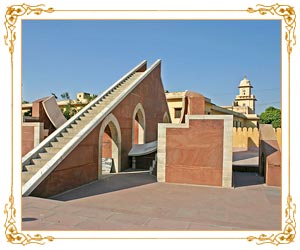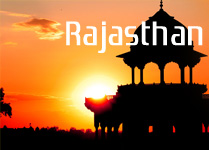 In Sanskrit, 'Jantar Mantar' is
used for 'Magical Devices' and it is undoubtedly so with the huge
masonry instruments, which were placed here to measure 'the harmony of
the heavens'. Conceived by Sawai Raja Jai Singh II, it was completed in
seven years from 1728 to 1734. Each instrument that forms a part of this
observatory is assigned and used for a particular function and is known
to give an accurate reading.
In Sanskrit, 'Jantar Mantar' is
used for 'Magical Devices' and it is undoubtedly so with the huge
masonry instruments, which were placed here to measure 'the harmony of
the heavens'. Conceived by Sawai Raja Jai Singh II, it was completed in
seven years from 1728 to 1734. Each instrument that forms a part of this
observatory is assigned and used for a particular function and is known
to give an accurate reading.The Samrat Yantra is a large sundial that looks like a triangular structure and is marked with hours and minutes. The arc at the left shows the time from sunrise to midday while the arc at the right side shows the time from midday to sunset. The time is read by observing where the shadow is sharpest at the time. The sundials have been constructed on latitude 27o north and to adjust the reading to the Indian standard Time (IST), one has to add anything between 1 minute 15 seconds to 32 minutes according to the time of year and solar position.
The Dhruva Yantra is used to locate the position of 12 Zodiac signs and also the Pole Star at night. The traditional unit of measurement started with the smallest unit being 'human breath' that has been calculated to be of 6 seconds duration. According to this scale, 4 breaths or 24 seconds equals 1 pal, 60 pals or 24 minutes equals 1 ghadi and 60 ghadis or 24 hours equals 1 day. The Narivalya Yantra is a distinctive sundial with two dials - the first dial facing south reads time when the sun is in the southern hemisphere, i.e., from 21 September to 21 March and the other one facing north reads time for the rest of the year when the sun is in the northern hemisphere, i.e., from 21 March to 21 September. The various other instruments include Jai Singh's seat (the seat of the Observer), Kranti Yantra used for direct measurement of the longitude and latitude of the extraterrestrial bodies, Raj Yantra or the King of Instruments used only once a year to calculate the Hindu calendar, Unnsyhsmsa yantra used for finding the altitudes of the heavenly bodies, the Chakra yantra that gives the angle of an object from the equator and Disha yantra or the compass that always points to the north.
Other instruments include Dakshina yantra used for observing the position and movement of heavenly bodies when passing over the meridian and the Large Samrat Yantra, is ten times larger than the Samrat Yanta and ten times more accurate too. It is accurate down to 2 seconds and is also used to predict the length and heaviness of the monsoon for the local area. The Rashivalayas Yantra has 12 sundials for the signs of the zodiac while Jai Prakash Yantra act as a double check on all the other instruments.















